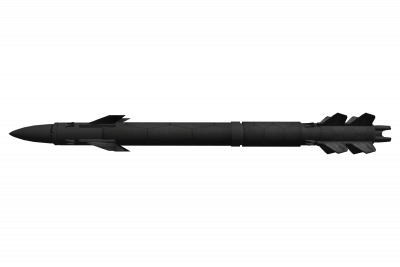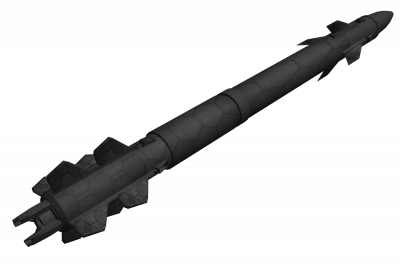Table of Contents
S-850TU 'Atrop' Short Range Surface/Air to Air Missile (SRSAAM)
| General Information | |
|---|---|
| Primary Users | Colonial Pact Trade Alliance |
| Start Date of Production | 963 N.C.C. |
| Per Unit Cost | 6,000 CC |
| Designation Index | |
| Specifications | |
| Weight | 350 Kg (771.61 Ibs) |
| Length | 3.41 m (11.18 ft) |
| Diameter (Widest) | 204 mm (8.03 in) |
| Range (Vacuum Use) | 12 LyS (0.02 AU) |
| Range (Atmospheric Use) | 400 Km |
| Speed | |
| One Standard Atmosphere (Below 7,000 Meters) - Mach 6 (2.05 KpS) - Vacuum - 0.5c (149,896 Kilometers per Second) |
|
| Control/Guidance System | |
| 1x ESC-78 Lightweight HSCC Package - Communication data-links are provided by both a radio and laser channel system capable of STL and FTL data speeds. |
|
| Sensors | |
| 1x PEMA-Type nose mounted passive system for tracking and targeting active electronic emissions. - 1x HOSTS-Type Electro-Optical Sensor System for passive guidance and ECCM Operations. - 1x EWPDITS-Type System for tracking and targeting exotic particle and waveform emissions. |
|
| Effective Sensor Range | Atmosphere 250 Km - Vacuum 8 LyS |
| Maximum Sensor Range | Atmosphere 400 Km - Vacuum 12 LyS |
| Armor and Structure | |
| Structure The Atrop's body consists of a Valadyne outer body with an interior Kylar Polymer webbing to reduce weight and keep overall structural strength. The outer body is also coated in a Cerrosteel ablative layer to reduce the effects of thermal stress on the interior. The forward sections feature rods of Decasteel for its annular blast warhead which pull double duty as armor against chance impacts on the guidance system. |
|
| Armor 50 mm Shell of 979-M Standard Military Grade Plating - 5 mm Interior Mesh of SV90 Standard Lightweight Shielding |
|
| Active Protection | |
| The missile employs an active CFA-Type shield system for general protection against interception and battlefield conditions, it has a failure point of 85.84 Gj and comes online once the missile has been launched. | |
| Propulsion and Powerplant | |
| Propulsion The missile employs a single cylindrical LISTM type solid fuel fusion drive system with plasma bleed ducting to provide steerage in thin or non-existent atmospheric conditions. When active it is also the primary power source for the missiles systems. |
|
| Powerplant The missile's primary power source when under storage conditions is a set of CCEC type capacitors linked to a small 'beer' can sized CFTB Type fission system, effectively giving the ATGM a decades long shelf life when stored under proper conditions. These systems are intended to have enough energy to ignite the drive motor when the missile is fired and are usually a secondary source of power once the motor is supplying the needed energy while in flight. |
|
Related articles here.
The S-850TU 'Atrop' is a short range (by Pact space combat standards) missile originally intended as a 'dogfighting' weapon for Pact fighters and strikecraft. However its smaller size and continuously upgraded guidance system and sensors systems have led its role to expand into everything from missile based point defense to surface to air roles.
Principly a passively guided missile system employing electro-optical, multi-spectrum, EM tracking, and exotic energy signature tracking. These systems paired with an advanced guidance control computer with a pre-loaded set of targets capable of differentiating between countermeasures and the target craft 50 to 60 percent of the time depending on ambient conditions.
General Information
This section covers the more general information of the Atrop SRSAAM missile.
Storage State and Use
The missile once manufactured is typically stored in a polymer casing until use, generally rectangular and designed to stack with munitions of its type. When opened the missile is revealed which is typically the main hull with the six fins detached to reduce the missiles overall size in storage. These are attached before the missile is loaded and can be configured into either a folded setup for launch tubes or left hanging free for standard hardpoint use. The primary linkage is covered by a throw away panel and must be uncovered and hard linked into the launch vehicle during installation.
Guidance and Control Options
The missile employs a single ESC-78 type processor with a multitude of programmed behaviors, tasking capabilities, and guidance modes. The weapon system can be launched in these parameters or simply aimed at a target and left in an automatic fire and forget mode. These can be altered or changed by the launching platform or the guiding platform in flight as needed via either and encrypted laser or radio data link.
Guidance Modes
- Semi-Active Command Line of Sight Optical
- A visual guidance mode that involves the launching platform or guiding platform visually tracking the target and guiding the weapon system in via their data link to the missile.
- Semi-Active Command Line of Sight Laser
- A visual guidance mode that involves the launching platform or guiding platform 'painting' the target with a laser designation system which the missile acquires at lock and then 'seeks'.
- Silhouette Lock Fire and Forget
- A visual 'pattern' type locking system in which the missile is trained on the spectral silhouette of a designated threat and then launched with pattern recognition software homing in on this specific signature in both visual and infrared. Effectively allowing the launching vehicle to acquire, fire or take cover from a threat.
- Optic Lock Fire and Forget with Mid Point Active Guidance
- Initially a visual semi-active guidance mode in which the launching vehicle or guiding platform directs the missile for the initial quarter or half of the flight before breaking the data link and switching the missile over to a active guidance mode. The weapon system then using its own sensors and targeting data to guide itself into the target allowing the launcher to slip away.
- 'Launch on Data Set' Fire and Forget
- An indirect attack method in which the launching platform fires the weapon on a data set from another platform's sensors, the weapon being uploaded with a specific threat target and a set of coordinates where the target will be. Once launched the weapon is 'fire and forget' using its own onboard sensor systems and data-links to find its way to the target.
Warhead
The primary production variant of the Atrop, known as the Primary Air Defense Variant or PADV, utilizes kinetic energy as its primary kill mechanism. The missile's guidance system features three options which it can determine based on the situation to achieve the highest possibility of a kill. The first is a 'skin-skin' kill where the total mass of the missile impacts the target, this typically produces the most damage as the entire mass of the missile is applied to the targeted craft. The second is a fragmentation sleeve warhead which blows the missile apart into a cloud of fast moving fragments covering a large area, this however has reduced damage with the trade off of a larger chance for a hit. The final type is a directional annular blast warhead in which the missile orients itself beside the target and at the optimum distance a internally facing warhead detonates propelling a cluster of high density metal rods in the direction of the target. The resulting damage is often compared to a saw blade as it tends to produce a line of damage to the targeted craft's hull.


